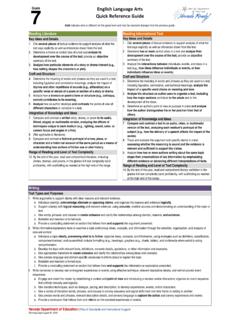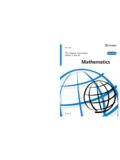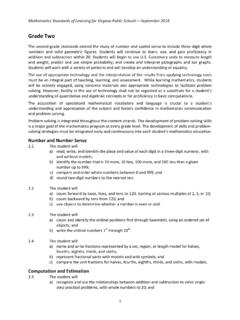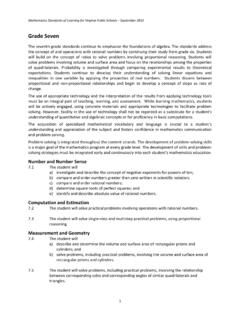Transcription of Nevada Academic Content Standards in Mathematics
1 1 | Page Nevada Academic Content Standards in Mathematics 2 | Page Table of Contents Introduction 3 Standards for mathematical Pr actice 6 Standards for mathematical Content Kindergarten 9 Grade 1 13 Grade 2 17 Grade 3 21 Grade 4 27 Grade 5 33 Grade 6 39 Grade 7 46 Grade 8 52 High School Introduction High School Number and Quantity 58 High School Algebra 62 High School Functions 67 High School Modeling 72 High School geometry 74 High School Statistics and Pr obability 79 Glossary 85 Sample of Works Consulted 91 3 | Page Introduction Toward greater focus and coherence Mathematic s experiences in early childhood settings should concentrate on (1 ) number (which includes whole number, operations, an d rela tions) and (2) geometry , spa tial rela tions, an d measurement, with more mathematic s learning time de voted to number than to other topics.
2 Mathematic al process goal s should be integrated in these Content areas. Mathematics Learning in Early Childhood, National Research Council, 2009 The composite Standards [of Hong Kong, Korea and Singapore] have a number of features that can inform an international benchmarking process for the development of K 6 mathematic s Standards in the First, the composite Standards concentrate the early learning of mathematic s on the number, measurement, and geometry strands with less emphasis on data analysis and little exposure to algebra. The Hong Kong Standards for grades 1 3 devote approximately half the targeted time to numbers and almost all the time remaining to geometry and measurement.
3 Ginsburg, Leinwand and Decker, 2009 Because the mathematic s concepts in [ ] textbooks are often weak, the presentation becomes more mechanical than is ideal. We looked at both traditional and non-traditional textbooks used in the US and found this conceptual weakness in both. Ginsburg et al., 2005 There are man y ways t o organize curricula. The challenge, now rarely m et, is to avoid those that distort Mathematics and turn off students. Steen, 2007 For over a decade, research studies of Mathematics education in high-performing countries have pointed to the conclusion that the Mathematics curriculum in the United States must become substantially more focused and coherent in order to improve Mathematics achievement in this country.
4 To deliver on the promise of common Standards , the Standards must address the problem of a curriculum that is a mile wide and an inch deep. These Standards are a substantial answer to that challenge. It is important to recognize that fewer Standards are no substitute for focused Standards . Achieving fewer Standards would be easy to do by resorting to broad, general statements. Instead, these Standards aim for clarity and specificity. Assessing the coherence of a set of Standards is more difficult than assessing their focus. William Schmidt and Richard Houang (2002) have said that Content Standards and curricula are coherent if they are: articulated over time as a sequenc e of topics an d performanc es that are logical an d reflect, where appropriate , the sequential or hierarchical na ture of the disciplinar y Content from which the subject matter de rives.
5 Tha t is, what an d ho w students are taught should reflect not only the topics that fal l within a certain ac ad emi c discipline, but als o the key ideas that determine ho w knowledge is organized and ge nerated within that discipline. This implies that to be coherent, a set of Content Standards must evolve from pa rticulars ( , the meaning an d operations of whole numbers, including simple math facts an d routine computational procedures as sociated with whole numbers and fr actions) to deeper structures inherent in the discipline. These deeper structures then serv e as a means for connecting the particulars (such as an understanding of the rational number system and its properties).
6 (emphasis added) 4 | Page These Standards endeavor to follow such a design, not only by stressing conceptual understanding of key ideas, but also by continually returning to organizing principles such as place value or the properties of operations to structure those ideas. In addition, the sequence of topics and performances that is outlined in a body of Mathematics Standards must also respect what is known about how students learn. As Confrey (2007) points out, developing sequenced obstacles and challenges for the insights about meaning that derive from careful study of learning, would be unfortunate and unwise. In recognition of this, the development of these Standards began with research-based learning progressions detailing what is known today about how students mathematical knowledge, skill, and understanding develop over time.
7 Understanding Mathematics These Standards define what students should understand and be able to do in their study of Mathematics . Asking a student to understand something means asking a teacher to assess whether the student has understood it. But what does mathematical understanding look like? One hallmark of mathematical understanding is the ability to justify, in a way appropriate to the student s mathematical maturity, why a particular mathematical statement is true or where a mathematical rule comes from. There is a world of difference between a student who can summon a mnemonic device to expand a product such as (a + b)(x + y) and a student who can explain where the mnemonic comes from.
8 The student who can explain the rule understands the Mathematics , and may have a better chance to succeed at a less familiar task such as expanding (a + b + c)(x + y). Mathematical understanding and procedural skill are equally important, and both are assessable using mathematical tasks of sufficient richness. The Standards set grade-specific Standards but do not define the intervention methods or materials necessary to support students who are well below or well above grade-level expectations. It is also beyond the scope of the Standards to define the full range of supports appropriate for English language learners and for students with special needs. At the same time, all students must have the opportunity to learn and meet the same high Standards if they are to access the knowledge and skills necessary in their post-school lives.
9 The Standards should be read as allowing for the widest possible range of students to participate fully from the outset, along with appropriate accommodations to ensure maximum participaton of students with special education needs. For example, for students with disabilities reading should all ow for use of Braille, screen reader technology, or other assistive devices, while writing should include the use of a scribe, computer, or speech-to-text technology. In a similar vein, speaking and listening should be interpreted broadly to include sign language. No set of grade-specific Standards can fully reflect the great variety in abilities, needs, learning rates, and achievement levels of students in any given classroom.
10 However, the Standards do provide clear signposts along the way to the goal of college and career readiness for all students. The Standards begin on page 6 with eight Standards for Mathematical Practice. 5 | Page How to read the grade level st andards Standards define what students should understand and be able to do. Clusters are groups of related Standards . Note that Standards from different clusters may sometimes be closely related, because Mathematics is a connected subject. Domains are larger groups of related Standards . Standards from different domains may sometimes be closely relate These Standards do not dictate curriculum or teaching methods.
















